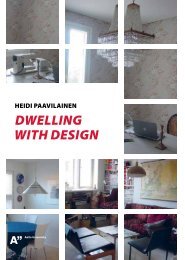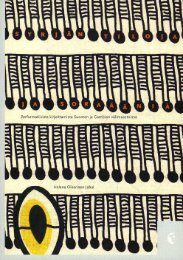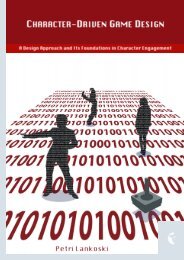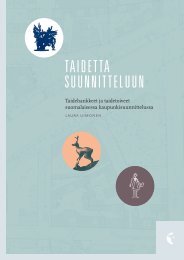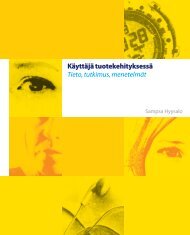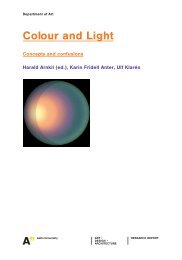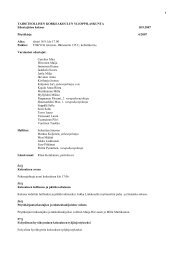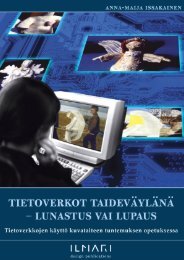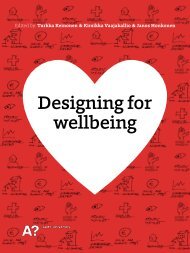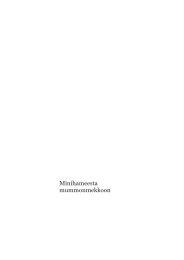Design games as a tool, a mindset and a structure Kirsikka Vaajakallio
Design games as a tool, a mindset and a structure Kirsikka Vaajakallio
Design games as a tool, a mindset and a structure Kirsikka Vaajakallio
You also want an ePaper? Increase the reach of your titles
YUMPU automatically turns print PDFs into web optimized ePapers that Google loves.
Creative interplay between current practices <strong>and</strong> future<br />
opportunities<br />
With Situated Make Tools it w<strong>as</strong> possible to study people’s practices in<br />
parallel with making a design intervention. New underst<strong>and</strong>ing w<strong>as</strong> produced<br />
in the <strong>as</strong>sumed use context, <strong>and</strong> it w<strong>as</strong> grounded to those people’s<br />
interpretation design concepts were targeted to. Being in a possible use<br />
context maintained the link between the current practises <strong>and</strong> the envisioned<br />
situations, <strong>as</strong> Buur <strong>and</strong> Søndergaard (2000) have also claimed.<br />
When observing with eyes open for change instead of being eyes open for<br />
observing, the context evoked new ide<strong>as</strong> <strong>and</strong> opportunities for the researchers<br />
<strong>as</strong> well (see more <strong>Vaajakallio</strong> & Mattelmäki 2007). The stance<br />
taken by the researchers at the study w<strong>as</strong> to listen first what the ageing<br />
workers proposed <strong>and</strong> then address his/her own suggestions evoked by<br />
the observations, to test ide<strong>as</strong> immediately with the workers. Facilitators’<br />
roles are discussed more thoroughly in the next chapters.<br />
What can be considered <strong>as</strong> a possible shortcoming of the approach is<br />
the exceptionally dynamic <strong>and</strong> unpredictable setting that is difficult to<br />
control: the enacted scenarios took place in various locations, outdoors<br />
<strong>and</strong> indoors, inside one building or between many buildings. Another<br />
possible shortcoming is the resources required since only one user participated<br />
at a time; hence there were <strong>as</strong> many gatherings <strong>as</strong> there were<br />
involved users. The improvisational character of the Situated Make Tools<br />
raises a question about how well these types of sessions can be planned<br />
beforeh<strong>and</strong> without losing the sensitivity towards arousing design opportunities<br />
that at le<strong>as</strong>t partly result from being continuously alert.<br />
2<br />
<strong>Design</strong> materials <strong>as</strong> <strong>tool</strong>s in ideation<br />
As stated by Ehn <strong>and</strong> Kyng (1991), even simplest mock-ups can create<br />
h<strong>and</strong>s-on-experiences <strong>and</strong>, besides designers’ idea generation, support users’<br />
thinking <strong>as</strong> well. Their unfinished nature can be seen <strong>as</strong> an advantage<br />
since it distinguishes them from real objects; people see them <strong>as</strong> ideation<br />
<strong>tool</strong>s instead of considering them <strong>as</strong> representations of the final design<br />
(ibid.). We noticed that the Make Tools were abstract enough to be understood<br />
<strong>as</strong> a design language but concrete enough for the workers to offer<br />
insights on mobile technology. For instance, a woman from the cleaning<br />
maintenance staff reflected upon a recent phone call from an unsatisfied<br />
client while envisioning properties for a dream device (<strong>Vaajakallio</strong> & Mattelmäki<br />
2007). Although having the open-character Make Tools guided<br />
discussion <strong>and</strong> thinking; they were created b<strong>as</strong>ed on early <strong>as</strong>sumptions of<br />
alternative design opportunities, consequently limiting the solution space<br />
<strong>as</strong> well. For example, one of the maintenance men came up with an idea of a<br />
smart vest, but he couldn’t demonstrate his vision with the provided design<br />
material. The form of a mock-up he w<strong>as</strong> able to build likely influenced his<br />
idea on how to use the device, <strong>as</strong> we discussed in (Ylirisku et al. 2007).<br />
3<br />
24



